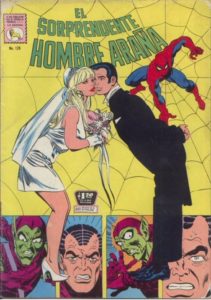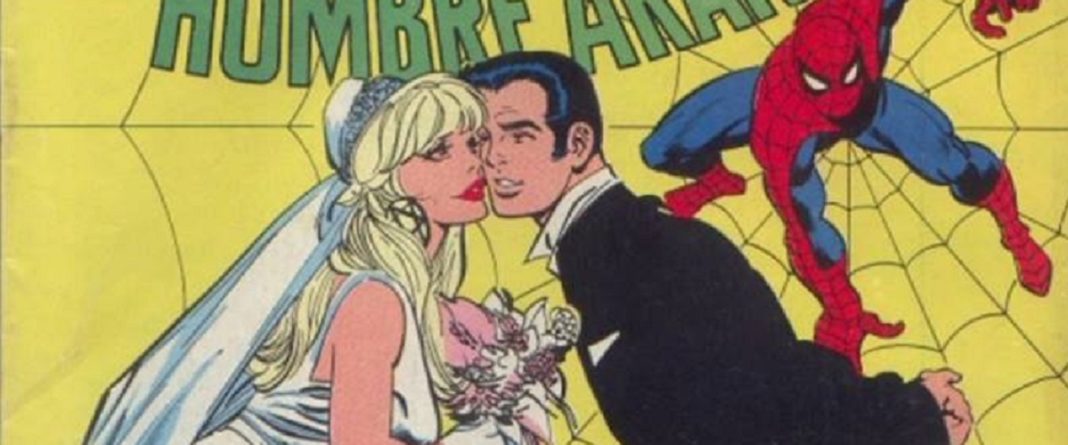
The cover was shared a whole bunch, major comics sites did interviews with the artist, and a good time was generally had by all. Some wondered if the cover was a fake, but lo and behold, it was totally legit! Marvel, it turned out, licensed Spider-Man to Mexican publisher La Prensa in the ‘70s, and so it goes. Thursday at Comic-Con, Mexican translator and artist Adalisa Zarate went over that story, sharing extra details before discussing other times borrowing from American comics and Japanese anime/manga had birthed a score of original (if slightly familiar) ideas in Mexico.
These borrowed ideas ranged from satirically-compelling — a political cartoon pig with the same powers as Superman — to straight-up stolen: a foe for the popular Mexican superhero Kaliman was visually identical to Galactus, just with his name changed to El Rojo Loco (The Angry Red) and his origin tweaked to be the Soviet Union rather than the cosmos.
More on that borrowing later, because it’s really interesting and shows the value in tailoring common ideas from one culture for mass consumption by another (much like we did here in America with the beautiful Pixar film, Coco). First things first, though: let’s go over the insights Zarate shared about that Spider-Man run.
The key here is it was very much like our Amazing Spider-Man during that time. Many of its issues were actually just translations of American ones. Where American comics were monthly, though, Mexican comic books were published weekly. Mexican artists would translate one book a month, and do three new ones of their own. All well and good when Marvel was putting out self-contained one-shot stories. When Spider-Man moved toward ongoing narratives and continuity, that complicated things…especially when Gwen Stacy died.
“In Mexico, we didn’t like that idea,” Zarate said. “We liked Gwen Stacy, and, let’s be honest, we liked sexy ladies.”
So, Mexican artists simply skipped her death, creating a butterfly effect of storytelling differences that included Gwen becoming more of an equal to Peter, going to work at one point for an archaeologist and later becoming an intrepid driven reporter much like Lois Lane (more borrowing).
This, Zarate noted, was all done with the market interest of Mexican readers in mind, although through a certain perspective, it could also be seen as visionary, as fan fic wish-fulfillment decades before that concept entered the American zeitgeist. Isn’t it true, she asked, that a Mexican comic that marries Gwen Stacy and gives her the agency of a skilled reporter is not all that dissimilar from the recent Ghost-Spider story in which an alternate reality Gwen Stacy gets powers instead of Peter?
“However, this is not the first time Mexico decided to do its own thing with comics,” Zarate said. “It’s just the most famous right now because of the Internet. Copyright in Mexico has always been: it’s a good idea and we’ll follow it as a guideline, but it’s not a law.”
She described a half dozen interesting examples of times creators ignored the guidelines, including one super popular comic that combined Transformers with Star Wars with Battlestar Galactica.
“It was a very popular comic because it took everything from something else, including a whole issue of Doctor Strange,” she said.
Amazing. And that’s Doctor Strange #16, for those wondering. Another time, a publisher lost the rights for the war comic Blackhawk, and just kept doing the book anyway, dropping the color while keeping Hawk as a title with all the plotlines and characters. There’s also a character in Mexican comics with the same origin as Batman, except he lives in Mexico City and wears a Lucha mask.
The list goes on, even crossing into a manga adaptation of the anime Captain Tsubasa, an ‘80s property about soccer known in Mexico as Super Campiones de Futbol. The manga sometimes featured whole Christmas specials that weren’t in the anime as well as the occasional reference to the Virgin of Guadalupe.
Anyway, as is clear by the length of this story, I was really into this panel, so much so that I could have probably listened to another 20-some descriptions of Mexican adaptations of other properties, taking in all the tweaks made and the cultural reasons they made them.
I’ve gone on enough, so I’ll just close on this quote, which I think gets at the heart of why this is all so fun.
“They were all fan fic,” Zarate said. “They were wish fulfillment, and in its way, Mexico was years ahead. Why were we limiting ourselves to the guidelines, we thought, why don’t we play outside the box?”










Hello I just wanted to let people know that I’ve left a link to this page since I used info for a post I’ve done. Mexican comics aren’t just legalized fan-fics you know: https://gutternaut.net/2018/07/la-patria-es-primero-for-the-historietas-of-mexico/
Comments are closed.